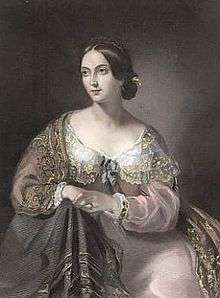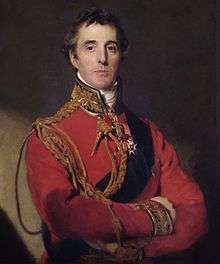Catherine Wellesley, Duchess of Wellington
| Catherine Wellesley | |
|---|---|
|
Her Grace Duchess of Wellington | |
 Engraving by J R Swinton, made in 1850 from an 1810 sketch | |
| Title held | 3 May 1814 – 24 April 1831 |
| Successor | Lady Elizabeth Hay |
| Spouse(s) | 1st Duke of Wellington |
|
Issue | |
| Father | 2nd Baron Longford |
| Mother | Catherine Rowley |
| Born |
14 January 1773 Dublin, Ireland |
| Died |
24 April 1831 (aged 58) Stratfield Saye, England |
Catherine Sarah Dorothea Wellesley, Duchess of Wellington (née Pakenham; 14 January 1773 – 24 April 1831) was the wife of the 1st Duke of Wellington. She is commonly known as Kitty Pakenham.
Early life
The daughter of Edward Pakenham, 2nd Baron Longford and the former Catherine Rowley, she was born Catherine Pakenham on 14 January 1773 in Dublin, Ireland. She became "The Honourable Catherine Pakenham" when her father succeeded as the 2nd Baron Longford in 1776. She had met Wellesley in Ireland when they were both young, and Wellesley, after numerous visits to the Longford's Dublin home, made his feelings towards her clear. At the time her family disapproved of the match: Wellesley was the third son of a large family and looked to have little in the way of prospects. After the rejection by the Pakenhams, Wellesley became serious about his military career, was posted to the Netherlands and India, enjoyed a spectacular rise, and seemingly forgot Kitty. Although she remained hopeful that they would be reunited, she admitted to a friend, Olivia Sparrow, after many years that she thought the "business over". She became engaged to Galbraith Lowry Cole, the second son of the Earl of Enniskillen, but Sparrow, who was in contact with him, revealed that Wellesley still considered himself attached to her. After much soul-searching, Pakenham broke off the engagement to Cole, although she believed the stress of the affair damaged her health.
Marriage to Arthur Wellesley
Pakenham had been a pretty, vivacious girl when Wellesley had met her ten years before, but she was thin, pale and in poor health by the time he informed Sparrow that he was returning to England and that she should "renew the proposition he had made some years ago" on his behalf. Pakenham feared that Wellesley felt bound by promises he had made ten years earlier and was in two minds as to whether to accept the proposal. Despite his more formal proposal after he had obtained her brother's permission, she insisted that he should see her in person before committing himself. Wellesley travelled to Ireland to meet her, and although he was obviously disappointed in the change in her (he said to his brother "She has grown ugly, by Jove!"), went ahead with the marriage. The couple were married on 10 April 1806, by Wellesley's clergyman brother Gerald, and after a brief honeymoon, Wellesley returned to England. Kitty followed him and after a stay with his brother while Wellesley continued to inhabit his bachelor's lodging, they set up home together in Harley Street.
Though she regained something of her former health, the two did not get on well together. Wellesley was a man of action as well as frugal and reserved with a sharp wit; Kitty lacked worldly experience, was easily roused to jealousy and fussed around him. With little in common, Wellesley could not help but give the impression that he found her poor company and although she bore him two sons, Arthur, in 1807, and Charles, in 1808, they lived apart for most of the time and occupied separate rooms in the house when they were together. Her brother, Edward "Ned" Pakenham, served under Wellesley throughout the Peninsular War and Wellesley's regard for him helped to smooth his relations with Kitty, until Ned Pakenham's death at the Battle of New Orleans in 1815.
Wellesley remained in Portugal and Spain during the entire Peninsular War, not returning to England until 1814. Kitty aged quickly, becoming dumpy and short-sighted, causing her to squint when talking. Wellesley found her vain and vacuous. It appears that she indeed loved him, but contented herself by doting on her sons and four adopted children. Wellesley confided to his closest female friend, Harriet Arbuthnot, that he had "repeatedly tried to live in a friendly manner with her...but it was impossible...& it drove him to seek that comfort & happiness abroad that was denied him at home". Harriet, whose own relations with Wellesley remain a subject of speculation, had a rather low opinion of Kitty – "such a fool" – but disputed Wellesley's claim that she cared nothing for his happiness; in a rare moment of sympathy she wrote that Kitty wanted above all to make her husband happy, but had no idea how to do it.
Duchess of Wellington
She became the Duchess of Wellington on Wellesley's creation as the Duke of Wellington on 3 May 1814 and eventually joined him in France when he was appointed Ambassador after Napoleon's exile to Elba. Lady Elizabeth Yorke commented that "her appearance, unfortunately, does not correspond with one's notion of an ambassadress or the wife of a hero, but she succeeds uncommonly well in her part."
Maria Edgeworth, however, found her "delightful" and "amiable" and commented that "After comparison with crowds of other beaux spirits, fine ladies and fashionable scramblers for notoriety, her graceful simplicity rises in our opinion, and we feel it with more conviction of its superiority."
Germaine de Staël described Kitty as "adorable".
Death
She became seriously ill in 1831, which brought Wellington to her bedside. She ran a finger up his sleeve to find if he was still wearing an amulet she had once given him, "She found it, as she would have at any time these past twenty years, had she cared to look for it" remarked Wellington.[1] "How strange it was", he went on to say, "that people could live together for half a lifetime and only understand each other at the end"[2] She died on 24 April.
References
- Christopher Hibbert (2001). Wellington: A Personal History. Da Capo. p. 480. ISBN 0-7382-0148-0.
- Richard Holmes (2002). Wellington: The Iron Duke. London: Harper Collins. ISBN 0-00-713750-8.
- "Hon. Catherine Sarah Dorothea Pakenham". thePeerage.com. Retrieved 17 May 2007.
- Maria Edgeworth (2004). The Life And Letters of Maria Edgeworth. Kessinger Publishing. p. 260. ISBN 1-4191-6937-8.
| Honorary titles | ||
|---|---|---|
| Preceded by The Viscountess Goderich |
Spouse of the Prime Minister of the United Kingdom 1828–1830 |
Succeeded by The Countess Grey |
| Peerage of Great Britain | ||
| New title | Duchess of Wellington 1814–1831 |
Succeeded by Lady Elizabeth Hay |
